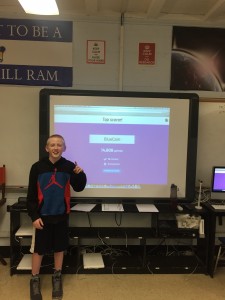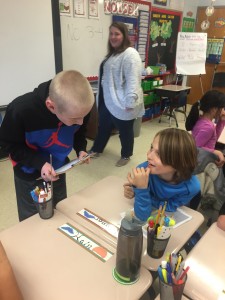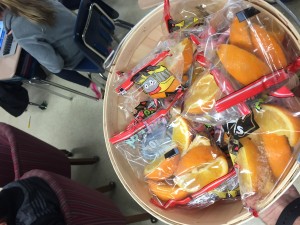 I just had the most AMAZING week of school. First, we finished our song ,but that is not all BILL GATES is going to listen to them!!!!!!!!!! Next, we got to see the UT steel drum band. Lastly, I got to have donuts with my totally AMAZING dad!!!!!!! My week was outstanding.
I just had the most AMAZING week of school. First, we finished our song ,but that is not all BILL GATES is going to listen to them!!!!!!!!!! Next, we got to see the UT steel drum band. Lastly, I got to have donuts with my totally AMAZING dad!!!!!!! My week was outstanding.
Month: February 2016
My Court Case
Human_Computer Led School from Jordan Haney on Vimeo.
UT Steel Drum Band
UT Steel Drum Band from Jordan Haney on Vimeo.
My Song
My Great 24th Week Of School
I just had a great week of school. First, we got to do our court cases and it was awesome. Next, we got to finish our song about opinion and informative papers. Lastly, I made it to the finals in running and later today I will see if I get to be on the track team. I have been on the running for the track team every year here. That is why my week was so great.
My Pollution Prompt
Pollution
By: Blue Cain
Have you ever saw trash just lying around and it made you want to do something about it? Well in the texts “Drinking Water: Bottled or from the Tap?” by Catherine Clarke Fox and “Art for Ocean Animals” by Elise Jonas-Delson, they are doing something about it. The two texts are talking about the very heated issue pollution. In this essay, I will compare and contrast the authors point of view on pollution.
The authors point of view is very similar in numerous ways. One example, is in both “Drinking Water: Bottled or from the Tap?” by Catherine Clarke Fox and “Art for Ocean Animals” by Elise Jonas-Delson agree that pollution is bad. In both text the authors state that pollution is affecting our earth, our animals, and our lives. My second example, is that they both think that people are needed if we want to fix the issue of pollution which is getting bigger and bigger every day. My third and final reason, is that they both mention that recycle can be turn into something that betters our lives. In the passage “Drinking Water: Bottled or from the Tap?” it states that recycle can be turned into cozy fleece clothing our a nice carpet and in “Art for Ocean Animals” by Elise Jonas-Delson the author states that recycle can be turned into beautiful art and magnificent sculptures. In conclusion, the authors have very homologous opinions on pollution.
Even with the many similarities the authors still have a very disparate point of view on pollution. One example, is in “Drinking Water: Bottled or from the Tap?” by Catherine Clarke Fox they only mention ways to help on land and the passage states that you can help by picking up trash and just recycling it. Unlike, that “Art for Ocean Animals” by Elise Jonas-Delson only mentions ways to help on land. One example is that the passage says that you should create something with it or just recycle it. Also, the author in “Drinking Water: Bottled or from the Tap?” by Catherine Clarke Fox only mentions the affects that it will have on us not our animals or environment. The passage indicates that if we don’t start recycling our earth could become endangered. While on the other hand the article “Art for Ocean Animals” by Elise Jonas-Delson they mention how the animals are being affected. For example, the passage vocalizes that many turtles are being caught in nets that are just floating around in the ocean and sadly the turtles slowly die. The text “Art for Ocean Animals” by Elise Jonas-Delson mentions how one person can effect pollution. It states that the one girl is affecting the issue of pollution. On the other hand, the passage “Drinking Water: Bottled or from the Tap?” by Catherine Clarke Fox it says that everyone is needed to stop pollution. The text states that one person really doesn’t have an effect on pollution, but if we all work together we can stop it. The two passages “Drinking Water: Bottled or from the Tap?” by Catherine Clarke Fox and “Art for Ocean Animals” by Elise Jonas-Delson are different in numerous ways.
I can finalize, that the authors have very alike yet divergent opinions of the issue of pollution. I know that I am glad that people are stepping up and doing something because even today we are seeing dramatic affects with our environments, food chains, and our daily lives. So next time you see a piece of recycle lying around, please just pick it up and just recycle it.
My Rescue Dog Prompt
Rescue Dogs
By: Blue Cain
Do you train your dogs? Well in the two recent articles “Hide-and-Seek School” by Vivienne Lenk and “It’s a Dog’s Life” by Rebecca Upjohn Snyder they take training to a whole new level because these dogs are not just normal dogs. They are trained professionals. Based on those two articles, I can conclude that the dogs in “Hide-and-Seek School” by Vivienne Lenk and “It’s a Dog’s Life” are a vital part of the owner’s life and company. In this essay, I will compare and contrast the dogs from “It’s a Dog’s Life” by Rebecca Upjohn Snyder and “Hide-and-Seek School” by Vivienne Lenk.
In this first paragraph, I will compare the dogs from “It’s a Dog’s Life” by Rebecca Upjohn Snyder and “Hide-and-Seek School” by Vivienne Lenk. Based on the information from the text, I can conclude that both dogs are very loyal to there owner. In “It’s a Dog’s Life” by Rebecca Upjohn Snyder it states that the dogs can come and go with just a simple command, and in “Hide-and-Seek School” by Vivienne Lenk it tells us that even with the many distractions the dog will stay focused loyal to its handler. In both text it states that the dogs are very anxious and happy. In “It’s a Dog’s Life” by Rebecca Upjohn Snyder it exclaims that the dogs are jumping around, and that there tails are wagging, and in “Hide-and-Seek School” by Vivienne Lenk it tells us that the dogs have to be held back because they are so excited to go find the “victim” of the “avalanche”. Based on the information from the text I understand that the dogs are a vital part of the team. In “Hide-and-Seek School” by Vivienne Lenk it says that it takes many people to find a victim of an avalanche but a single dog can find a victim in a matter of minutes, and also in “It’s a Dog’s Life” by Rebecca Upjohn Snyder it states that a human has to take a long time to herd animals and often the animals do not cooperate. Fortunately, the dogs can do in a very little amount of time. In conclusion, the dogs in “Hide-and-Seek School” by Vivienne Lenk and “It’s a Dog’s Life” by Rebecca Upjohn Snyder are similar in numerous ways.
Even with the many similarities the dogs are also very different. One example is in “It’s a Dog’s Life” by Rebecca Upjohn Snyder. The dogs are trained to herd farm animals for the owner. I know this because the passage states that the dogs herd anything from sheep to goats. Unlike, the dogs in “Hide-and-Seek School” by Vivienne Lenk are trained to find people buried in many feet of snow. The passage states that the dogs are held back until going to find the “victim” that is buried in snow. Another example is in “It’s a Dog’s Life” by Rebecca Upjohn Snyder there is only one dog mentioned in the text. The text states that he is being worked with alone. Unlike, “It’s a Dog’s Life” by Rebecca Upjohn Snyder in “Hide-and-Seek School” by Vivienne Lenk there are four different dogs being trained. The passage states that their names are Rube, a golden retriever mix, Rudy, a Labrador mix, Roux, a golden retriever, and Kodi, an Australian shepherd. Not only the characters but the setting also changes. In the passage “It’s a Dog’s Life” by Rebecca Upjohn Snyder, the passage is a calm and peaceful farm in the country. The passage states that the dog was running around herding the sheep and you can’t have a farm in the city. In contrast the passage “Hide-and-Seek School” by Vivienne Lenk the setting is in the quite, but rugged mountains of Colorado. The passage states the dogs run through the snow covered mountains. Those were just a few of the differences that the dogs from “It’s a Dog’s Life” by Rebecca Upjohn Snyder and “Hide-and-Seek School” by Vivienne Lenk have.
Based on the information from the text I can finalize that the dogs from “Hide-and-Seek School” by Vivienne Lenk and “It’s a Dog’s Life” by Rebecca Upjohn Snyder have many similarities and differences. Trust me, if I were a farmer or an avalanche victim I would want those dogs to be there. So, next time you see a rescue dog or a herd dog, stop for a moment and think about how it makes a difference in our lives. In conclusion, working dogs are not just pets, they are trained to perform jobs that save our lives.
My Pluto Prompt
Why I am for Pluto Being a Planet
By: Blue Cain
In the recent articles “What is a Planet” by Nasa and “When is a Planet Not a Planet” by Daniel Santos, I can conclude that you where debating the decision to reclassify Pluto as a dwarf planet was correct or incorrect. Unfortunately, the decision to reclassify Pluto as a dwarf planet caused such large disagreements among the people of the IAU, which is the company that made the decision to reclassify Pluto and the people of the world. I strongly believe that the decision to reclassify Pluto as a dwarf planet was incorrect because the third definition was vague and its awkward orbit.
I strongly believe that Pluto should be a planet because the definition of a planet was very vague and unclear. Both text exclaims that there was no definition until 2006, and the definition was made amongst only two people. Therefore, the people did not make the definition it was just made by two people who happen to think that Pluto should not be a planet. Because of the vague definition, I believe Pluto should be reclassified. But that is not the only reason why I disagree with the decision to reclassify Pluto.
Another reason why I disagree with the decision to reclassify Pluto as a dwarf planet is its awkward orbit. Earth, Mars, Jupiter, and Neptune all share their orbits with asteroids and comets. Because Pluto shares its orbit, it cannot be a planet. But technically, Neptune shares its orbit with Pluto, but Neptune is still considered a planet. Not only Neptune, but Earth, Mars, and Jupiter all share their orbits with comets and asteroids, but they are all still classified as planets. That is why I disagree with the decision to reclassify Pluto as a dwarf planet.
I strongly disagree with the reclassification of Pluto because of the vague third definition and its awkward orbit. I stated that the third definition was vague and that Earth, Mars, Jupiter, and Neptune all share their orbits with asteroids and comets and that they are still classified as planets. Based on the two recent articles “What is a Planet” by Nasa and “When is a Planet Not a Planet” by Daniel Santos, I still strongly disagree with the decision to reclassify Pluto as a dwarf planet.
